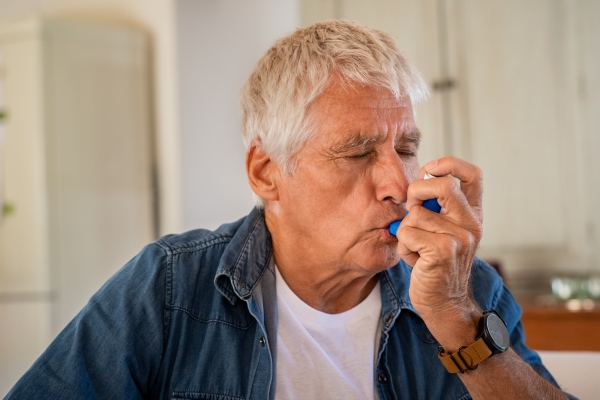Breathlessness is a common symptom of COVID-19 (coronavirus). Some people describe it as feeling ‘puffed’, ‘short of breath’ or ‘winded’.
The feeling of shortness of breath may continue for a while after your illness. This is a normal part of the recovery process.
Normal activities can make you feel breathless, for example:
- getting dressed
- walking to the bathroom
- doing jobs around the house
When you learn to control your breathing, your stamina will improve. You will then be able to do more before feeling short of breath.
Feeling breathless can make you feel panicked or anxious. This can make your breathlessness worse.
When you feel breathless you should try to:
- stop speaking and moving
- give yourself time to recover your breath
- relax or distract yourself by focusing on a picture or a view from the window
Managing breathlessness is about controlling your breathing. You can do this no matter how fast or shallow your breath.
Positions to help your breathing
Choose a position which will make it easier for you to breathe. It is important to try and relax in these positions. Focus on relaxing the muscles in your neck and shoulders.
Sitting leaning forward
Sit leaning forward resting your elbows on your knees or the arms of the chair.
Sitting leaning forward at a table
Sit leaning forward with your elbows resting on a table. You could put some pillows or cushions on the table for comfort.
Standing leaning forward
Lean forwards resting your elbows onto a chair, a wall or a railing. You could use a walking stick or a frame if you use one for walking.
Breathing techniques can be taught to you by your nurse or physiotherapist.
How to control your breathing
Relaxed Tummy Breathing
This breathing technique can help if you are breathless after doing any activity. It may help you feel more relaxed if you are feeling anxious or panicky.
Breathing from the tummy does not come naturally. You should practice it when you are not breathless. This will help you master the technique.
Practising tummy breathing
- Make sure you are in a comfortable position.
- Your head and back should be supported and shoulders and upper chest relaxed.
- Place one hand on your tummy.
- Feel the tummy rise and expand as you breathe in and relax down as you breathe out.
- Breathe gently when practising; there should only be a slight movement of your tummy at rest.
Breathe low and slow
Taking slower, deeper breaths from your tummy helps to ease breathlessness.
Breathe a rectangle
When you practice relaxed tummy breathing it might help to picture a rectangle. This could be a book, a TV, window, table top, or even a picture on the wall.
Pursed Lip Breathing
This can help if you are very breathless, become anxious or if you find tummy breathing difficult. This type of breathing allows more time for the air to leave your lungs, making it easier to take the next breath in.
Breathe in through your nose then breathe out through pursed lips. Continue until you feel your breathing is under control.
Check how breathless you are
COVID-19 usually affects the respiratory system. This can result in a lung injury that can take time to recover. This breathlessness scale will tell you how well your lungs are recovering.
The scale starts at the number 0 where your breathing is causing you no difficulty at all. It goes through up to 10, where your breathing is at its most difficult. Use this scale to monitor and guide you as you exercise. It’s important to take regular rests and stop before you get too short of breath.
| Modified BORG Breathlessness Scale | |
| 0 | Nothing at all |
| 0.5 | Extremely Slight (Just noticeable) |
| 1 | Very Slight |
| 2 | Slight |
| 3 | Moderate |
| 4 | Somewhat Severe |
| 5 | Severe |
| 6 | |
| 7 | Very Severe |
| 8 | |
| 9 | Extremely Severe (almost maximal) |
| 10 | Maximal |
When to get medical help
Shortness of breath can sometimes be serious and you’ll need to get medical help.
- your chest feels tight or heavy
- you have pain that spreads to your arms, back, neck and jaw
- you feel or are being sick
You could be having a heart attack or a problem with your lungs or airway.
Phone your GP if you have shortness of breath and:
- your breathing changes from what is normal
- it gets worse when you have been active
- it gets worse when you lie down
- you have been coughing for 3 weeks or more
- you have swollen ankles
Quit smoking
If you smoke and you are feeling breathlessness, you should quit smoking.
Source. Health Service Executive

